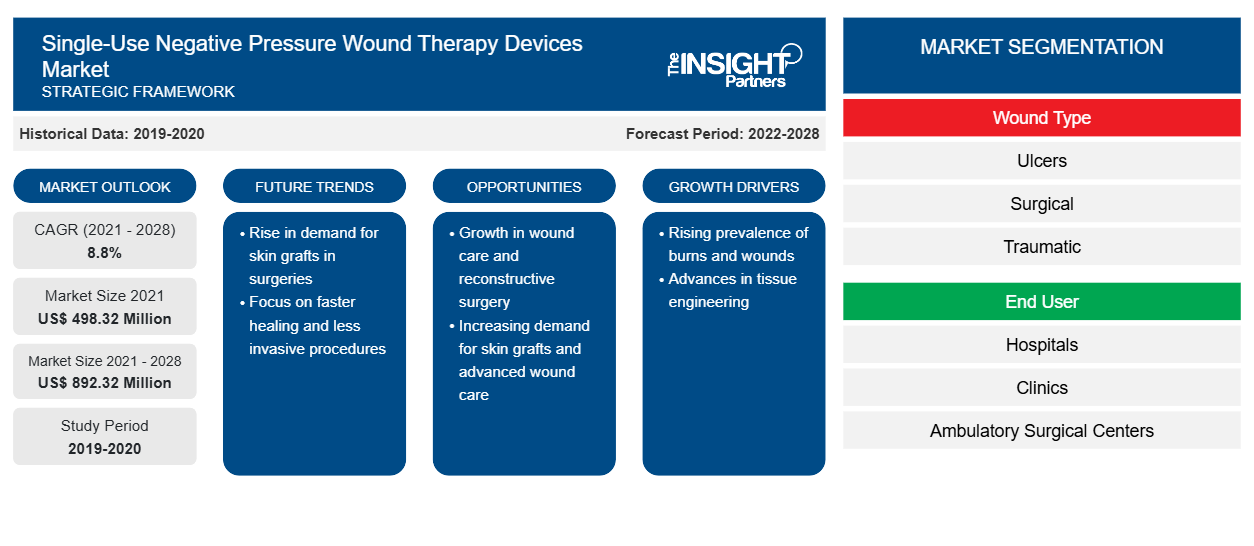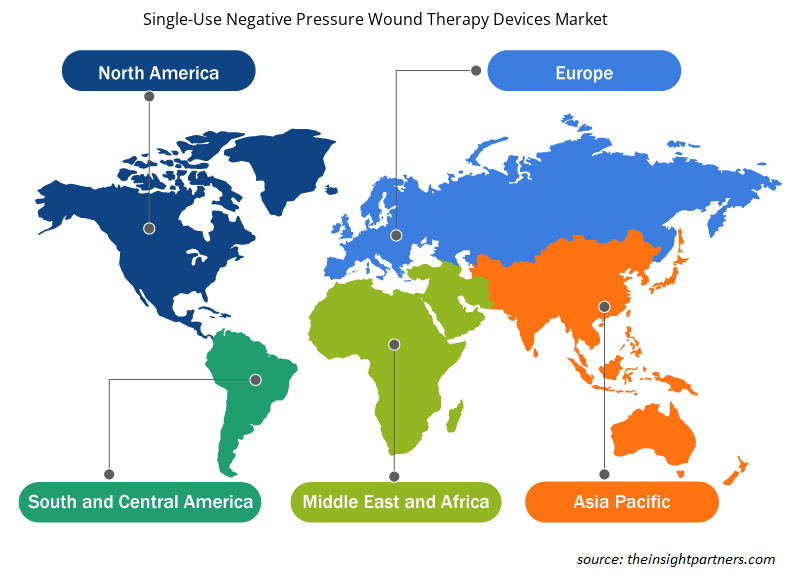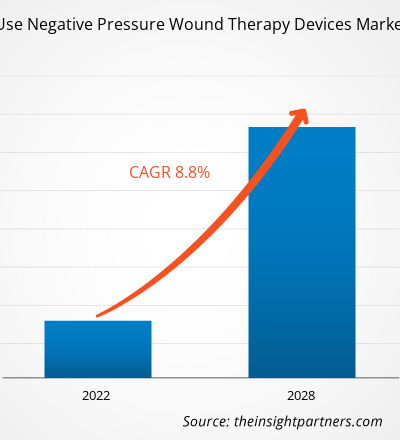Se proyecta que el mercado de dispositivos de terapia de heridas con presión negativa de un solo uso alcance los US$ 892,32 millones para 2028 desde los US$ 498,32 millones en 2021; se espera que registre una CAGR del 8,8% entre 2021 y 2028.
La terapia de presión negativa para heridas (NPWT, por sus siglas en inglés) se utiliza para tratar una amplia variedad de tipos de heridas, incluidas las heridas traumáticas, las de difícil curación y las crónicas. También se utiliza para tratar heridas cubiertas con colgajos o un injerto de piel. Esta terapia se transforma en un dispositivo médico, como un dispositivo NPWT de un solo uso, que es un pequeño dispositivo de bolsillo que funciona con batería. Como sugiere el nombre, se trata de dispositivos desechables y portátiles que se utilizan generalmente para la atención ambulatoria.
El informe ofrece información y un análisis profundo del mercado de dispositivos de terapia de heridas con presión negativa de un solo uso, haciendo hincapié en varios parámetros como las tendencias del mercado, los avances tecnológicos, la dinámica del mercado y el análisis del panorama competitivo de los principales actores del mercado en todo el mundo. También incluye el impacto de la pandemia de COVID-19 en el mercado en todas las regiones. El mercado de dispositivos de terapia de heridas con presión negativa de un solo uso experimentó un déficit al comienzo de la crisis de COVID-19 debido a la interrupción en la cadena de suministro y la caída de la demanda debido al bloqueo anunciado por la mayoría de los países del mundo que causó interrupciones en la fabricación y las operaciones en el sector farmacéutico. Además, los servicios para el cuidado de heridas crónicas se han reducido drásticamente en el primer y segundo trimestre de 2020, pero se han normalizado a fines de 2020. Además, para reducir la contaminación cruzada a través de dispositivos, las personas prefieren los dispositivos desechables. El uso creciente de dispositivos NPWT desechables (de un solo uso) está impulsando su demanda en el mercado global de dispositivos de terapia de heridas con presión negativa de un solo uso. Además, se ha producido una importante reducción de la afluencia de pacientes hospitalizados y ambulatorios en las cadenas de hospitales privados. Para aliviar los sistemas sanitarios, muchas clínicas han pospuesto el diagnóstico y el tratamiento, salvo en los casos de COVID-19. Por ejemplo, en la India, el hospital estatal de Victoria, afiliado al Bangalore Medical College and Research Institute (BMCRI), se convirtió en un centro dedicado a la COVID-19 desde que la pandemia azotó Karnataka en marzo; el funcionamiento de la sala de quemados Mahabodhi del hospital no se ha visto afectado. A pesar de la pandemia, el hospital siguió funcionando con normalidad, siguiendo todas las precauciones contra la COVID-19.
Personalice este informe según sus necesidades
Obtendrá personalización en cualquier informe, sin cargo, incluidas partes de este informe o análisis a nivel de país, paquete de datos de Excel, así como también grandes ofertas y descuentos para empresas emergentes y universidades.
Mercado de dispositivos de presión negativa de un solo uso para el tratamiento de heridas: perspectivas estratégicas

-
Obtenga las principales tendencias clave del mercado de este informe.Esta muestra GRATUITA incluirá análisis de datos, desde tendencias del mercado hasta estimaciones y pronósticos.
El tratamiento de heridas crónicas durante la pandemia fue una tarea muy difícil para ambas partes: pacientes y médicos. Para minimizar el riesgo de exposición durante la pandemia, los pacientes utilizaron dispositivos desechables en lugar de los dispositivos NPWT convencionales. Debido a preocupaciones de salud, las personas prefirieron usar productos de un solo uso para tratar heridas crónicas y agudas. Este factor respaldó el crecimiento del mercado durante la situación de pandemia. El mercado de dispositivos de terapia de heridas con presión negativa de un solo uso está segmentado por tipo de herida, usuario final y geografía. El mercado, según la región, está segmentado en América del Norte, Europa, Asia Pacífico, Medio Oriente y África, y América del Sur y Central.
Perspectivas de mercado
Aumento de casos de quemaduras
En 2019, se identificaron un total de 8.378.122 nuevos casos de quemaduras en todo el mundo. Las tasas de mortalidad por quemaduras han ido disminuyendo en muchos países de altos ingresos, pero las muertes infantiles por quemaduras son ahora aproximadamente 7 veces mayores en los países de ingresos bajos y medios que en los países de altos ingresos. El sistema de terapia de heridas con presión negativa de un solo uso se utiliza para tratar heridas agudas y crónicas e incisiones quirúrgicas cerradas con niveles de exudado bajos a moderados. La terapia de heridas con presión negativa (NPWT) implica la aplicación de presión negativa (vacío) a una herida para controlarla y promover la curación. La terapia con presión negativa tópica (TNP), el cierre asistido por vacío (VAC) y la succión de heridas de superficie sellada son otros de los nombres para la NPWT. La NPWT se utiliza para ayudar a drenar el exceso de líquido y mejorar el flujo sanguíneo localizado en pacientes con quemaduras. Se ha sugerido que la acción de la NPWT puede resultar en un mayor suministro de oxígeno y nutrición a la quemadura, lo que promueve la curación. El sistema de terapia de heridas con presión negativa de un solo uso está destinado a personas que se beneficiarían de un dispositivo de succión (terapia de heridas con presión negativa), ya que ayuda a promover la cicatrización de heridas al eliminar cantidades bajas a moderadas de exudado y residuos infecciosos. Las heridas crónicas, agudas, traumáticas, subagudas y dehiscentes; las quemaduras de espesor parcial; las úlceras (como las diabéticas o por presión); los colgajos e injertos; y las incisiones quirúrgicas cerradas son ejemplos de tipos de heridas aceptables.
Además, según el Children's Burn Trust y la British Burn Association, 625 niños son admitidos en un Servicio de Quemaduras del NHS cada mes debido a lesiones por quemaduras o escaldaduras. En 2017, los servicios de quemaduras y escaldaduras del NHS trataron a más de 15.000 pacientes con estas lesiones, con un costo total de más de US$ 24,94 millones (es decir, GBP 20 millones). Más de 40 del total de admisiones por tratamiento de quemaduras en 2017 se clasificaron como extremadamente graves, con procedimientos de tratamiento que costaron más de US$ 118.455,50 (GBP 95.000) por persona. Las quemaduras causadas por accidentes domésticos e industriales están aumentando en regiones en desarrollo como Asia Pacífico, África y Oriente Medio. Por lo tanto, el mercado de dispositivos de cuidado de heridas con presión negativa de un solo uso está siendo impulsado por un aumento en el número de casos de quemaduras y lesiones similares.NHS Burns Service each month owing to burn or scald injuries. In 2017, the NHS's burns and scalds services treated more than 15,000 patients with these injuries, with a total cost of more than US$ 24.94 million (i.e., GBP 20 million). More than 40 of the total burn treatment admissions in 2017 were classified as extremely serious, with treatment procedures costing more than US$ 118,455.50 (GBP 95,000) per person. Burns caused by home and industrial mishaps are rising in developing regions such as Asia Pacific, Africa, and the Middle East. Therefore, the market for single-use negative pressure wound care devices is being driven by an increase in the number of occurrences of burns and similar injuries.
Información basada en el tipo de herida
El mercado mundial de dispositivos de terapia de heridas con presión negativa de un solo uso, según el tipo de herida, se ha segmentado en úlceras, heridas quirúrgicas, heridas traumáticas, heridas deportivas, colgajos e injertos y quemaduras. En 2022, el segmento traumático representó la mayor participación del mercado; además, se espera que continúe su dominio durante el período de pronóstico. Este tipo de herida es la más común debido a la creciente prevalencia de accidentes de tránsito y casos de traumatismos. Además, se espera que el segmento traumático registre la CAGR más alta durante 2021-2028.CAGR during 2021–2028.
Información basada en el usuario final
Según el usuario final, el mercado de dispositivos de terapia de heridas con presión negativa de un solo uso se ha segmentado en hospitales, clínicas, centros quirúrgicos ambulatorios y otros. El segmento de hospitales tuvo la mayor participación del mercado en 2022 y se estima que registrará la CAGR más alta durante el período de pronóstico.CAGR during the forecast period.
Los actores del mercado de dispositivos de terapia de heridas con presión negativa de un solo uso adoptan estrategias orgánicas como el lanzamiento y la expansión de productos para expandir su presencia y cartera de productos en todo el mundo y satisfacer la creciente demanda.
Perspectivas basadas en la geografía
Por geografía, el mercado de dispositivos de terapia de heridas con presión negativa de un solo uso está segmentado en América del Norte (EE. UU., Canadá y México), Europa (Francia, Alemania, Reino Unido, España, Italia y el resto de Europa), Asia Pacífico (China, India, Japón, Australia, Corea del Sur y el resto de APAC), Medio Oriente y África (Arabia Saudita, Emiratos Árabes Unidos, Sudáfrica y el resto de MEA) y América del Sur y Central (Brasil, Argentina y el resto de América del Sur y Central).APAC), the Middle East & Africa (Saudi Arabia, the UAE, South Africa, and the Rest of MEA), and South & Central America (Brazil, Argentina, and the Rest of South & Central America).
Perspectivas regionales del mercado de dispositivos de terapia de heridas con presión negativa de un solo uso
Los analistas de Insight Partners explicaron en detalle las tendencias y los factores regionales que influyen en el mercado de dispositivos de terapia de heridas con presión negativa de un solo uso durante el período de pronóstico. Esta sección también analiza los segmentos y la geografía del mercado de dispositivos de terapia de heridas con presión negativa de un solo uso en América del Norte, Europa, Asia Pacífico, Medio Oriente y África, y América del Sur y Central.

- Obtenga datos regionales específicos para el mercado de dispositivos de terapia de heridas con presión negativa de un solo uso
Alcance del informe de mercado sobre dispositivos de terapia de heridas con presión negativa de un solo uso
| Atributo del informe | Detalles |
|---|---|
| Tamaño del mercado en 2021 | US$ 498,32 millones |
| Tamaño del mercado en 2028 | US$ 892,32 millones |
| CAGR global (2021-2028) | 8,8% |
| Datos históricos | 2019-2020 |
| Período de pronóstico | 2022-2028 |
| Segmentos cubiertos |
Por tipo de herida
|
| Regiones y países cubiertos |
América del norte
|
| Líderes del mercado y perfiles de empresas clave |
|
Densidad de actores del mercado de dispositivos de terapia de heridas con presión negativa de un solo uso: comprensión de su impacto en la dinámica empresarial
El mercado de dispositivos de terapia de heridas con presión negativa de un solo uso está creciendo rápidamente, impulsado por la creciente demanda de los usuarios finales debido a factores como la evolución de las preferencias de los consumidores, los avances tecnológicos y una mayor conciencia de los beneficios del producto. A medida que aumenta la demanda, las empresas amplían sus ofertas, innovan para satisfacer las necesidades de los consumidores y aprovechan las tendencias emergentes, lo que impulsa aún más el crecimiento del mercado.
La densidad de actores del mercado se refiere a la distribución de las empresas o firmas que operan dentro de un mercado o industria en particular. Indica cuántos competidores (actores del mercado) están presentes en un espacio de mercado determinado en relación con su tamaño o valor total de mercado.
Las principales empresas que operan en el mercado de dispositivos de terapia de heridas con presión negativa de un solo uso son:
- Salud Cardenal Inc.
- Grupo ConvaTec Plc
- Carilex Médico
- Genadyne Biotecnologías, Inc.
- Atención sanitaria H y R
Descargo de responsabilidad : Las empresas enumeradas anteriormente no están clasificadas en ningún orden particular.

- Obtenga una descripción general de los principales actores clave del mercado de dispositivos de terapia de heridas con presión negativa de un solo uso
Perspectivas basadas en la empresa
Cardinal Health Inc; ConvaTec Group Plc; Carilex Medical; Genadyne Biotechnologies, Inc.; H and R Healthcare; Lohmann & Rauscher GmbH & Co. KG; Medela AG; Mölnlycke Health Care AB; Paul Hartmann Ag; y Smith & Nephew plc se encuentran entre las empresas líderes que operan en el mercado de dispositivos de terapia de heridas con presión negativa de un solo uso.
- Análisis histórico (2 años), año base, pronóstico (7 años) con CAGR
- Análisis PEST y FODA
- Tamaño del mercado, valor/volumen: global, regional y nacional
- Industria y panorama competitivo
- Conjunto de datos de Excel
Informes recientes
Testimonios
Razón para comprar
- Toma de decisiones informada
- Comprensión de la dinámica del mercado
- Análisis competitivo
- Información sobre clientes
- Pronósticos del mercado
- Mitigación de riesgos
- Planificación estratégica
- Justificación de la inversión
- Identificación de mercados emergentes
- Mejora de las estrategias de marketing
- Impulso de la eficiencia operativa
- Alineación con las tendencias regulatorias






















 Obtenga una muestra gratuita para - Mercado de dispositivos de terapia de heridas con presión negativa de un solo uso
Obtenga una muestra gratuita para - Mercado de dispositivos de terapia de heridas con presión negativa de un solo uso